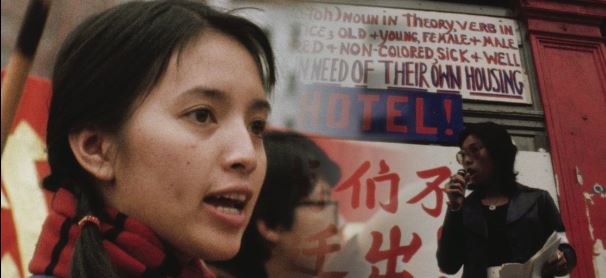- Nevada Theatre Box Office dedicated to Lisa Moon - January 25, 2025
- Volunteers Needed - March 25, 2024
- Nevada City Chinese Lunar New Year Festival and Parade - August 31, 2023
Exploring the The Chinese from the Gold Rush to the Railroad to the Documentary
During the California Gold Rush in 1849 and in subsequent years, Nevada County, along with many foothill towns of the Sierra Nevada, had a very vibrant Chinese population. They arrived from southern China in the early 1850s, driven to seek a better life, escaping overwhelming poverty and a civil war (the Taiping Rebellion). While thousands of Chinese mined for gold in the Sierra rivers and streams, they were later recruited in 1863 as the major workforce in building the Central Pacific Railroad. The Central Pacific was the western portion of the Transcontinental Railroad, which started from Sacramento and ended in Promontory, Utah, in 1869, where it linked up with the Union Pacific Railroad, the eastern portion. The Transcontinental Railroad was the most advanced infrastructure at that time, uniting the eastern and western portions of the country, boosting the nation’s mobility, economy, commerce, and how Americans lived their lives. It even changed the way the military fought the Civil War! Historians today have long recognized the Chinese effort as unparallel. With only picks, shovels and black powder, they risked their lives by blasting tunnels and laying tracks through the treacherous Sierra Nevada granite, endured harsh winters, suffered immense hardship, discrimination, and even death. In addition to the Transcontinental Railroad, the Chinese built many roads in California, like the famed Tioga Road in Yosemite National Park, as well as numerous roads within and outside the Park and in neighboring counties, to name a few.
Sadly, life for the Chinese in the Sierra foothills, and in many rural towns in the Pacific Northwest, was not easy. A movement swelled from anti-Chinese sentiment. As their populations grew, the hate grew. Eventually, thousands were forcibly driven out; Chinatowns were looted and burned; employers were forced to fire their Chinese workers; and boycott of Chinese goods and services was rampant. Even our very own Nevada Theatre hosted an anti-Chinese rally. The once vibrant populations in these rural communities were no more. (Driven Out, by Jean Pfaelzer, 2007, Random House.)
Where did the Chinese go? Town after town, the destruction was like a pandemic that kept spreading; terror followed them everywhere. It is probably safe to speculate that, ultimately, many found refuge in metropolitan areas like San Francisco, where The Chinese Six Companies (Chinese Consolidated Benevolent Association), functioned like a social agency, where immense support was available. They helped them return to China, if they wanted to, shipped their deceased back to China for burial, provided assistance with housing, jobs, education, etc.
San Francisco Chinatown was not just a geographical area, but a breathing life force that was, and still is, ever-changing. About a hundred years after the building of the Transcontinental Railroad, and against the backdrop of the Civil Rights Movement of the mid-1960s, a young San Francisco Chinatown resident, named Harry Chuck, armed with a 16mm camera and leftover film scraps from a local TV station, turned his lens onto his community. Totaling more than 20,000 feet of film (10 hours), his exquisite unreleased footage has captured a divided community’s struggles for self-determination. Chinatown Rising is a documentary film about the Asian American Movement from the perspective of the young residents on the front lines of their historic neighborhood in transition. Through publicly challenging the conservative views of their elders, their demonstrations and protests of the 1960s-1980s rattled the once quiet streets during the community’s shift in power. Forty-five years later, in collaboration with his son Josh, Chinatown Rising presents intimate interviews with the activists as they recall their roles and experiences in response to the need for social change.
Today, Nevada County honors and celebrates the early Chinese of the Sierra Foothills. Community Asian Theatre of the Sierra, in collaboration with Onyx Downtown, presents Chinatown Rising on Sunday, June 11, at 7:00 p.m. at the Nevada Theatre, as one of its cultural enrichment programs. Our mission is to offer films, workshops, tours, speakers, activities and events that deepen our understanding of the Asian-American experience; they are a companion program to our annual theatrical productions. CATS recently concluded Lauren Yee’s The Great Leap at the Nevada Theatre. This film is especially timely — coming full circle — since Nevada County was once home to a large population of Chinese well over a hundred years ago. Did many of them settle in San Francisco? We can only speculate. How have the needs of their descendants been met? Meet the filmmakers, Harry Chuck and Josh Chuck, after the screening. Chinatown Rising has screened all over the country in film festivals, independent movie theaters, Ethnic Studies and classrooms, organizations seeking social change, and more! For tickets, visit https://theonyxtheatre.com. A portion of the ticket price supports CATS’ Cultural Enrichment Programs. The film’s website is https://www.chinatownrising.com

0 comments on “Nevada County’s Connection to Chinatown Rising”